The Rediff Special/ Gita Aravamudan


I lay on my bed weak after childbirth. My mother-in-law picked up the baby and started feeding her milk. I knew what she was doing. I cried and tried to stop her. But she had already given her milk laced with yerakkam paal [the poisonous juice of the oleander plant]. Within minutes, the baby turned blue and died," Karuppayee says matter-of-factly.
It was my very first face-to-face encounter with female infanticide. My first instinct was disbelief. Could a woman really speak so dispassionately about the murder of her own child? A life she had carried in her womb for nine months... I didn't realise then how little control she had over her own life, let alone her womb.
Now, almost 10 years later, I hear the alarm bells again. According to the latest census figures, female infanticide, foeticide and every other form of female infant genocide seems to be alive and kicking. The national female-male sex ratio has dipped to an all-time low of 933/1000. In some states, the situation is dire. Haryana, for example, has 861 females to 1,000 males. Chandigarh has 773. Daman and Diu, 709. Punjab, 874. The sex ratio of children in the 0-6 age group is no better. While the all-India figure is 927/1000, it is 793 in both Punjab and Haryana. Tamil Nadu is the small, lone light at the end of the tunnel with its figure of 986/1000, which is marginally higher than the corresponding national one.
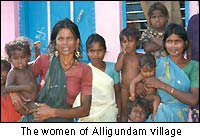 To go back to my story, I met Karuppayee outside a tiny hovel in Alligundam village, in Usilampatti taluk [block] of Tamil Nadu's Madurai district. The year was 1993, nearly a decade after a leading national magazine had broken the story on female infanticide in Usilampatti.
To go back to my story, I met Karuppayee outside a tiny hovel in Alligundam village, in Usilampatti taluk [block] of Tamil Nadu's Madurai district. The year was 1993, nearly a decade after a leading national magazine had broken the story on female infanticide in Usilampatti.
A stinking open drain gurgled past us. Karuppayee had just come in from the fields. Barely 25, she carried her two-year-old son on her hip while her four-year-old daughter clung to her faded cotton sari. Abject poverty could not get more abysmal. The child who had been killed was her third one... If it had been a boy, he would have been allowed to live.
Penn sisu kolai, as female infanticide is known in local parlance, is a widespread and socially accepted phenomenon in this area. Talking about it to an outsider is, however, taboo.
Finally, I zeroed in on Alligundam village with the help of Jayanti, who was working for the Indian Council for Child Welfare at Usilampatti. Though the focus of the ICCW project was on gathering statistics, the women working there also tried to prevent infanticide by convincing expectant mothers to deliver their children in hospitals, where they had a chance of rescuing the infant if it was a girl.
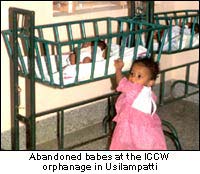 The ICCW also had a small orphanage, where a cradle was set outside for unwanted babies. This was the famous 'cradle baby' scheme initiated by then chief minister J Jayalalithaa, who appealed to mothers to leave their babies in the cradles instead of killing them. The scheme, however, did not generate much response. In one year, only seven girl babies were left in the crib whereas over 700 'disappeared' shortly after birth.
The ICCW also had a small orphanage, where a cradle was set outside for unwanted babies. This was the famous 'cradle baby' scheme initiated by then chief minister J Jayalalithaa, who appealed to mothers to leave their babies in the cradles instead of killing them. The scheme, however, did not generate much response. In one year, only seven girl babies were left in the crib whereas over 700 'disappeared' shortly after birth.
Jayanti described the hostile situations her team faced in the villages every day. The male-centric Thevar and Kallar communities were resentful of these pottachinga (contemptuous term for women) who came and corrupted their women with evil ideas.
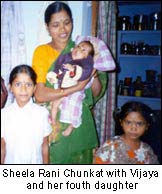 On the way to Alligundam, Jayanti told me about two of her colleagues who, just a few days ago, had been keeping a close watch on Lakshmi, a woman who was due to deliver her third child. Though Lakshmi was in the high-risk group because she had already borne two girls, she had refused to go to hospital for her delivery.
On the way to Alligundam, Jayanti told me about two of her colleagues who, just a few days ago, had been keeping a close watch on Lakshmi, a woman who was due to deliver her third child. Though Lakshmi was in the high-risk group because she had already borne two girls, she had refused to go to hospital for her delivery.
The two social workers who stood outside her house waiting for the child to be born put up with the jeers and name-calling for a couple of hours. But when a couple of men, bearing their trademark aruvaals (choppers), appeared threateningly on the scene, the young women got intimidated and moved away. By the time they returned, Lakshmi's girl child had been born, killed and buried. They had even placed a stone on the burial spot to avoid detection. The social workers did not dare ask any questions.
Traditionally, unwanted girl children are fed milk laced with either yerakkam paal or paddy husk as soon as they are born. The husk method is more cruel; it slits the tender gullet with its sharp sides as it slides down the tiny throat. The more 'modern' families use pesticides or sleeping pills. Sometimes, they just suffocate the infant with a pillow.
Alligundam was an eye-opener in many ways. The families there were aggressively protective of their right to eliminate their female children. An elderly Thevar, after giving me a long lecture on the need for female infanticide, suddenly shouted angrily, "Who told you we kill penn sisus (female infants) in this village? Go and see... you will find at least one girl child in every house."
What he omitted to say was that the next... and the next... and the next would be eliminated. The families believed that one girl was needed to "light the lamp" in each home; the others were intrusions who just had to go. They wanted more boys, so family planning was not an option. Karuppayee told me, "It is better they die than live like me."
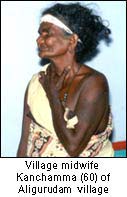 I also met 60-year-old Kanchamma, a village midwife who had witnessed the killing of many female infants. Her job, she said, was only to deliver the baby. What they did with it was a family decision. On rare occasions, though, she was able to persuade the family to give a girl child away for adoption. Kanchamma, with her native wisdom, had a perfect explanation as to why more girl babies were getting killed every year. "The value of a girl goes down every time the value of gold goes up," she said.
I also met 60-year-old Kanchamma, a village midwife who had witnessed the killing of many female infants. Her job, she said, was only to deliver the baby. What they did with it was a family decision. On rare occasions, though, she was able to persuade the family to give a girl child away for adoption. Kanchamma, with her native wisdom, had a perfect explanation as to why more girl babies were getting killed every year. "The value of a girl goes down every time the value of gold goes up," she said.
In 1993, of the 800 female births registered in the Usilampatti hospital, 600 had 'disappeared'. No one even spoke of the unregistered births like the one Jayanti had described. There was no proper documentation. No real figures.
Five years later, I visited Salem and Dharmapuri districts on the Tamil Nadu-Karnataka border. In the intervening years, penn sisu kolai had become a political issue, forcing the Tamil Nadu government to take concrete steps to identify the problem and educate the people.
The female infanticide belt had been identified. It stretched through the districts of Salem, Dharmapuri, North Arcot, Periyar, Dindigul and Madurai. Hardcore regions like north Salem, south Dharmapuri, south Dindigul and west Madurai accounted for practically 70 per cent of all female infanticide in the state.
It also became clear that female infanticide knew no caste, community or socio-economic barriers. The popular conception that female infanticide was confined to the Kallar and Thevar communities in Madurai and the Gounders in Salem was wrong. It was also prevalent among communities like the Vanniars, Pariyars and Pallars in other areas. In one village, the panchayat [council] head had just eliminated his third daughter. In another, the richest and most powerful landlord had killed off his fourth.
In Dharmapuri, one of the worst affected areas, an average of 105 baby girls were killed every month in 1997. Evidence supporting this was collected from the records of the primary health centres operating in these areas. Of these, 260 deaths occurred in Pennagaram, where female literacy was just 31.3 per cent, well below the state average of 41.8 per cent. Between 1994 and 1997, almost 3,000 baby girls died here as soon as they were born. Which meant three female infants were killed each day in that area alone.
Sheela Rani Chungat, a rather dynamic IAS officer, was then the Tamil Nadu commissioner for maternal and child health and welfare. She launched an aggressive campaign to tackle the problem and managed to put together an authentic picture of the problem in Tamil Nadu, using data collected from PHCs. Unlike states like Rajasthan where the issue is pushed under the carpet, the Tamil Nadu government had brought it out into the open and was attempting to tackle it by organising special education programmes.
But in infanticide heartland, female infants were still being killed. At Nalampalli village near Salem, Palaniamma spoke of how her mother-in-law had just killed her sister-in-law's third daughter. "My husband's mother wrapped the newborn girl in a wet towel. She threw it on the ground and pushed it with her toe. 'Who wants this?' she said and went out of the room. All of us stood there, afraid to pick the baby up. My sister-in-law, who was weak after the delivery, just wept. A few hours later, the child died. They got a doctor's certificate to say it had pneumonia."
The year was 1999. They had discovered new and 'better' methods of killing.
Five years ago, in Usilampatti, the villagers were defiant and impervious to the opinion of city folk. Now, they were cautious and more secretive. Some parents had been arrested on charges of murder. And so the practice had gone underground.
From a quick and relatively painless procedure, it had turned into a prolonged and torturous one. "Now they are afraid of detection," said Alphonso Mary, a public health nurse who worked in the area. "If someone registers a case of suspected infanticide and the body is exhumed, the 'old' methods of killing can be detected."
As a result, modern methods had evolved. The newborn was deliberately weakened and dehydrated by its own parents. They did this by wrapping it in a wet towel or dipping it in cold water soon after delivery or as soon as it came home from hospital. If it was still alive after a few hours, it was taken to a doctor who diagnosed pneumonia and prescribed medicines. The prescription was carefully preserved, but the medicines were never bought. When the child finally died, the parents had a medical certificate to prove pneumonia. Sometimes, the infant was fed a drop of alcohol to create diarrhoea. Another certifiable 'disease'.
The villagers also learnt to cremate the little bodies. Once upon a time they would bury the killed infants in shallow graves in the fields, just putting a stone over the spot so that animals wouldn't get at them. Now it was different. Even modern methods of killing didn't help anymore.
Muniamma and Krishnan were agricultural labourers eking out a living in Kolasinahalli. The panchayat vice-president and the president of the local Nehru Yuvak Kendra registered a case of female infanticide against them when their third daughter died in suspicious circumstances a few hours after her birth. A post-mortem examination of the body, which was exhumed, revealed that the baby had been given a sedative, a benign but detectable method of murder.
Avoiding detection, therefore, had become as important as the killing itself, especially as even cremation aroused suspicion, burial being the usual practice.
Unfortunately, the ubiquitous scan which is responsible for the mass massacre of female foetuses in Punjab and Haryana has also found its way into this area. A sex determination scan can cost anything from Rs 300 upwards. The whole package, including abortion of the female foetus, costs about Rs 7,000. But many of the women I spoke to frankly admitted they couldn't afford the "luxury". It was cheaper to kill the infant after it was born.
At Krishnagiri, I tried to talk to a doctor. Most of the women had told me she was offering sex-selective abortion. One of the women I met, Padma, even showed me her scan result with a tiny F scribbled in the corner. She could not afford the abortion. Fortunately, the village nurse had persuaded her to keep her third daughter, who was now four months old.
This gynaecologist ran a flourishing clinic and was politically well connected. Obviously, she was unwilling to talk. Especially since she was already facing a court case filed against her by a man who had lost his wife during one such illegal procedure. The moment my journalist colleague and I presented her our cards, she got her husband on the phone and he started threatening us before we could even ask a question!
Village women call sex determination scans a city procedure, which has the same end result. They know now that penn sisu kolai is illegal. But so is sex determination scanning. So why should poor, illiterate villagers be arrested while rich city doctors go scot-free?
Female infanticide is prevalent in several parts of the country, though it is perhaps best documented in Tamil Nadu. In parts of Gujarat, mothers have been known to drown newborn infant girls in milk. In Rajasthan, there are entire villages where no girl has been born for decades. As for female foeticide, it is so widespread that in some interior villages of Punjab and Haryana, they say the mobile scan is more easily available than water supply! In Andhra Pradesh, tribal women have been selling their baby girls to unscrupulous agents. The list is endless.
But just when you are beginning to sink into depression, along come the bright spots.
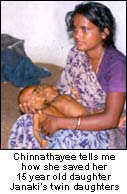 In 1993, I met Chinnathayye, a simple village woman who saved her 15-year-old daughter Janaki's twin girls after listening to ICCW social workers. The penniless widow faced stiff opposition from the girl's in-laws who refused to take Janaki back if she kept her babies. Yet, she refused to budge. After Janaki's delivery in hospital, Chinnathayee brought the babies to her hut by bus, carrying them in a cloth market bag. She raised them till Janaki's in-laws gave in and took her back.
In 1993, I met Chinnathayye, a simple village woman who saved her 15-year-old daughter Janaki's twin girls after listening to ICCW social workers. The penniless widow faced stiff opposition from the girl's in-laws who refused to take Janaki back if she kept her babies. Yet, she refused to budge. After Janaki's delivery in hospital, Chinnathayee brought the babies to her hut by bus, carrying them in a cloth market bag. She raised them till Janaki's in-laws gave in and took her back.
In Salem, Chungat took me to the house of Vijaya, a petty shopkeeper, who kept her fourth daughter after watching a street play on the evils of infanticide. At the Dharmapuri guesthouse where we were staying, many women came to proudly display the girl babies they had kept after seeing the plays organised under a Danida project.
I also met Sarojini, a nurse who had saved hundreds of children in the villages where she had worked for over 15 years. It had taken several years for her to win the confidence of the villagers. Even now, however, she has to tread on glass as she tries to save female babies.
The dilemmas continue... Can a woman who has no power over her womb be dubbed a murderer? Does a woman have a right to sell her child because she envisions a better life for it? Is it better to snuff out a life than let it survive in abject poverty and misery?
The Rediff Specials